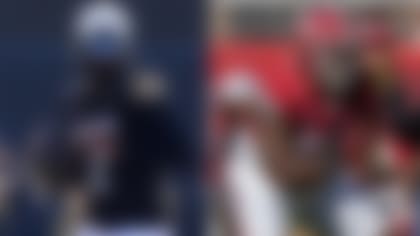NFL Media's Albert Breer touches on multiple topics in his robust Inside the NFL Notebook, including (click on each link to go directly to the topic):
» Why the coaching carousel might not spin as furiously as usual.
» The blueprint for stopping Jimmy Graham.
» How the Carolina Panthers positioned themselves for an improbable run.
And much more, beginning with a look at the difficulty of developing prospects in an NFL with high levels of coaching turnover. ...
The 2011 draft class has quickly built a reputation as one of the best to come along in decades. And if you really look at it, it's amazing those guys have developed the way they have.
As many of them complete their rookie deals and prep for a life-changing payday, another Black Monday is poised punctuate the challenge they've each faced getting here. Since that class entered the league, 18 of the NFL's 32 teams have changed coaches. Four teams -- the Cleveland Browns, Jacksonville Jaguars, Kansas City Chiefs and Tampa Bay Buccaneers -- are on their third coach in that timeframe, and that's not accounting for the clubs that went through large chunks of one of those seasons with an interim guy in place.
The problem here, as football people see it, is real. Players aren't developing like they used to for a variety of reasons -- and one of the first is related to environment.
"I think it has a tremendous effect on them," said one veteran offensive coordinator. "Players are drafted by coaches and the personnel staff for a reason -- they met a schematic element those guys had in mind. Most NFL coaches are good at developing people and players, but say that shift comes, then the new coach doesn't like something about the fit with a guy. There's no benefit of the doubt anymore, because he didn't draft him. So he's not getting better anymore."
Take the 2011 rookies for the aforementioned quartet of three-coach teams -- a pool of players that includes boom picks like Justin Houston, Cecil Shorts, Allen Bailey, Mason Foster and Jordan Cameron, and busts like Jon Baldwin, Greg Little and Blaine Gabbert.
Those guys entered the league in a lockout and under conditions where coaches were adjusting to rigid new rules that limited the time spent with -- and workload that could be imposed on -- players. And then there's the fact that each of those teams has gone through two coaching changes since, meaning the draftees in question have had, at best, just one (truncated) offseason with any measure of normalcy -- which is especially true for those who are no longer with their original squads.
This is probably a good time to mention that the great majority of players don't make it to a fourth credited year in the NFL, or to a second contract of any significance.
Everyone knows being drafted by Seattle, New England or Denver can be an advantage. All these conditions make it an even bigger edge than one might think at first glance.
An NFC general manager put it like this: "You have storms colliding," between the flood of underclassmen leaving college early and the growing gap between the college game, where schools are adjusting to simplify things for athletes, and the pro level, which continues to get more complicated.
The GM continued: "These kids are at their best when they're playing fast, when they're reacting. You can apply that to anyone in their job -- if you have to think too much, it slows you down. Then you take the lack of an offseason, there's too much time off, that's affecting the kid's ability to do his job. Now, if you keep changing scheme, add that to less time in the offseason, and they're constantly thinking instead of reacting."
The best test case over the past decade is probably Chiefs quarterback Alex Smith, taken first overall by the San Francisco 49ers in 2005. He was the first quarterback selected with a high draft pick to come out of a 2000s-era spread offense (at Utah), and he played for five different offensive coordinators, under two head coaches, in his first five years as a pro. In 54 games over that time, he completed 57.1 percent of his passes for 9,399 yards, 51 touchdowns, 53 picks and a 72.1 passer rating.
In 2011, coach Jim Harbaugh arrived in San Francisco, and he, offensive coordinator Greg Roman and quarterback coach Geep Chryst made a point to slow things down for Smith. Roman told me at the time, "You could tell he was taught a lot of different things. ... A lot of things were just a little bit off, because he's been told five different ways to do it. We thought if we could narrow his thought process, the benefits would show."
In 56 games since, Smith has completed 63.4 percent of his passes for 11,459 yards, 71 touchdowns, 23 interceptions and a 92.8 rating.
The flip side of this could be seen in Patriots running back Jonas Gray's 201-yard breakout against Indy in November. As the NFC GM sees it, "the unknown running back had a great game. It's because they know their scheme, they know what works best against that type of defense. And they can say, 'With what kind of back we have here, this is how we'll do it.' "
That's not to say Smith -- who will miss the regular-season finale with a lacerated spleen -- has suddenly turned into the NFL's best quarterback. But it's a pretty good example of what stability can do.
"It's hard, especially at quarterback, to go through change," said one AFC head coach. "You get three different coordinators in four years? That's hard. The more you're in a system, the more you're with the same guys, the better. That goes for everyone -- the offensive line, you have the same five guys working together, you're better for it. But change three years in a row? How are you playing fast when you're learning new things? How are you gonna adjust when new things come up?"
After a six-year stretch in which 45 coaching changes occurred, there are at least subtle signs of sanity.
In Miami, Ryan Tannehill, the eighth overall pick in 2012 -- who has an option coming up that could land him more than $16 million in 2016 -- was facing the possibility of learning his third offensive system in four years. Amid an internal assumption that the staff had to get to 9-7 to survive, Dolphins owner Stephen Ross called off the dogs when the team got to 8-7 last weekend, assuring the public that coach Joe Philbinwould be back for a fourth season.
Meanwhile, in Washington, coach Jay Gruden and quarterback Robert Griffin III have (at least for now) dispelled the notion that a divorce is inevitable, which spared Griffin the same circumstance Tannehill was staring at, whether in D.C. or somewhere else.
"You draft to fit a skill set for a position, and you'd like to think, from a football intelligence standpoint, guys, especially at quarterback, can adapt," said an AFC personnel director. "But the maturation and development of each guy, that process is impacted by his level of understanding as much as his intelligence. If there's a new system, it takes time for that system to take hold. It's repetition in a redundant process. You don't want to be spending more time learning than polishing and refining."
And too often, that's exactly what's happening.
Four downs
Schein: Week 17's burning questions

As the 2014 regular season winds down to completion, Adam Schein digs into the hottest topics across the NFL. **READ**
1) Running out of replacements. The dynamic discussed above should affect the way owners and franchises make their decisions over the next few days, going into Black Monday and beyond. But something far simpler figures to slow movement: a dearth of slam-dunk coaching candidates. In part because there have been 45 coaching changes over the last six cycles, and 23 over the last three, the pipeline has started to run dry. In 2009, a number of assistants whose names had been mentioned in previous years (Jim Schwartz, Rex Ryan, Josh McDaniels) were finally taking their first cracks at becoming head coaches. Now? Broncos offensive coordinator Adam Gase and Seahawks defensive coordinator Dan Quinn are the closest things to that, having been candidates last year. But even those two are fairly new as NFL coordinators; two years ago, Quinn was defensive coordinator at Florida and Gase was Peyton Manning's position coach. Certainly, the success of Jim Harbaugh, Pete Carroll and Chip Kelly will prompt more poaching from the college ranks, and there are qualified names at that level (Brian Kelly, David Shaw, Jim Mora, etc.). But there isn't necessarily a big fish out there, like Chip Kelly was in 2013 or Harbaugh was two years earlier. One NFC executive put it this way: "If you're Miami, do you stick with Joe Philbin, or is the guy who's replacing Joe Philbin gonna be that big an upgrade?" It's a fair question to ask, and a reason why as few as four clubs could be switching out head coaches.
2) The Texans' vision is shining through. Houston's first draft with Bill O'Brien as head coach drew a very clear picture of what he wanted: to transform what had become a soft team into a much more rugged and powerful group. Mission accomplished. Houston ran the ball 38 times against the always rough Ravenslast week, controlled it for almost 35 minutes and held Baltimore offensive coordinator (and former Texans boss) Gary Kubiak's vaunted ground attack to just 33 yards. Internally, all of that was viewed as a triumph of the process of the last year, and it gives the team a sturdy identity -- one that reflects O'Brien's beliefs -- going forward. And again, the makeup of the rookie class -- Houston's first four picks consisted of 266-pound outside 'backer Jadeveon Clowney, 307-pound guard Xavier Su'a-Filo, 265-pound tight end C.J. Fiedorowicz and 331-pound nose tackle Louis Nix -- confirms that. But it's also seen in the resourceful way the scouting staff was able to restock a roster with immediate needs and almost no salary-cap space, something that starts with how the team was able to tread water at quarterback by replacing the costly (and done) Matt Schaub with Ryan Fitzpatrick. Starting safety Kendrick Lewis and nose tackle Ryan Pickett, salvaged from the scrap heap, have become key to the Texans' defensive makeover, as has safety Danieal Manning, who returned five months after his ouster at a cheaper rate. And quarterback Ryan Mallett and linebacker Akeem Dent chipped in after coming over in low-end trades. Add this up -- along with a nine-win season, if Houston beats Jacksonville on Sunday -- and you can see why O'Brien and his overhauled operation seem very clearly headed in the right direction.
3) Is there a blueprint for stopping Jimmy Graham? It's not like the Saints' offense has collapsed as the team has unraveled -- Drew Brees has a good shot at reaching the 5,000-yard mark for the fourth straight year and the fifth time in his career, and the group leads the league in total yardage. There's most certainly more blame at the feet of a defense that has come undone in Year 2 under coordinator Rob Ryan. But the last few weeks have illustrated some issues the offense has had turning all those yards into points. And you might first look to Brees' most prolific weapon, he of the four-year, $40 million contract. Several Falcons players said after Sunday's win by Atlanta that the plan was to be physical with Jimmy Graham, who drew boos from the Superdome crowd after missing a couple of catchable balls in traffic and fumbling near the goal line (though the officials' call on that play was, to be fair, questionable). So what's going on? Well, Graham has spent a large chunk of the year nursing a shoulder injury that has, to some degree, mitigated his freakish athletic ability. But there's also a very real question as to whether a blueprint exists for stopping Graham. New England shut Graham out in Week 6 of 2013 -- the first time he'd been blanked since his rookie year -- by having Aqib Talib hammer him at the line of scrimmage. One rival personnel director affirmed that the Patriots "definitely" built a plan that's been replicated, adding, "If you have a physical safety or corner that can match up with him in man coverage, that's the best way." Now, it's not like Graham has disappeared since that contest last year, posting 128 catches for 1,457 yards and 20 touchdowns over his past 25 regular-season games. And yet, it does seem like he's been slightly less dominant. Again, taking the shoulder injury into account, he's cracked 100 yards in just three of those 25 games, after going for triple-digits in three of the four games prior to that loss to the Patriots. Given the overall numbers, it's tough to be too hard on Graham. But if it's become easier for opponents to take away or at least minimize the Saints' strength on offense, well, then that's made things even more difficult for Brees and Co.
4) Bengals buoyed by ... themselves. Back on Nov. 6, things weren't looking good for Marvin Lewis' crew. They'd been whooped at home by their cross-state rivals from Cleveland and seemed to be sinking with a 5-3-1 record. Their third 20-point loss in 32 days blew apart the good vibes of a 3-0 start. Season over? Not quite. In fact, all the Bengals have done since is show -- again -- the machine they've become when it comes to developing talent, both on the roster and the staff. New coordinators Hue Jackson (offense) and Paul Guenther (defense) have gotten their footing and pushed forward in filling holes and building identities for their units. Cincinnati has been the NFL's third-best running team since the Browns loss, averaging 162.3 yards per game, mostly behind rookie Jeremy Hill, whose 620 yards over that period (on a 5.5-yard per-carry average) leads the league. And that's allowed linemen Andrew Whitworth and Kevin Zeitler to play the best ball of their careers. Meanwhile, the defense has held four of six opponents during this 5-1 stretch to 13 points or less, and that's due in part to strides made by corner Dre Kirkpatrick (whose game-changing pick-six was huge against Denver last Monday), safety George Iloka and linebacker Rey Maualuga. As one Bengals source put it, "The system is working." Kirkpatrick and Zeitler -- guys the team kept developing through early struggles who are now having success -- are living proof. It might seem weird to view Cincinnati as a model franchise, but Lewis has made the Bengals one, from the standpoint of finding talent (director of player personnel Duke Tobin deserves credit there) and harvesting it within their building. More than anything else, that's why they're in the playoffs for a fourth straight year, with another division title on the line Sunday against Pittsburgh.
Three checkdowns
1) As there is from time-to-time with high-profile hires, there was a boatload of skepticism over Dennis Hickey getting the Miami GM post. Eleven months later, hard to argue with his results. Before he was lost for the year with a knee injury sustained in Week 10, Branden Albert might have been 2014's best free-agent signing. And the picks of Ja'Wuan James and Jarvis Landry were home runs. The payoff? Fighting for his job again in '15.
2) I was talking to someone in San Diego about Philip Rivers, and how this is the Rivers they always see, and another name came up: Manti Te'o. The coaches are impressed with how he's improved on a week-to-week basis. As a player whose instincts were a strength coming out of Notre Dame in 2013, Te'o's comfort level within defensive coordinator John Pagano's scheme has allowed him to play more on natural feel.
3) Those who moan about the prospect of a seven-win NFC South champion hosting a 12-win Arizona team routinely miss the real reason for the circumstance: the number of divisions. The 2002 realignment produced eight four-team divisions, which cut the level of competition and the number of divisional games. Want to fix it? Go back to six divisions. Yes, the league would be unbalanced, and there'd be scheduling challenges. But the NFL has dealt with that before.
Two college players to watch this week
Oregon DE Arik Armstead, vs. Florida State in the national semifinal at the Rose Bowl, Thursday, 4:30 p.m. ET, ESPN: The focus will be on the quarterbacks, but the battle between Florida State's offensive line and Oregon's defensive line could dictate where this mega-matchup swings. And while DeForest Buckner is the Ducks' premier D-lineman, Armstead is a rare athlete, and probably the top concern for a Seminole front that boasts four likely NFL draft picks. "No. 9 (Armstead) is extremely gifted," said one NFL GM. "He has first-round talent, no doubt. The more he shows us in the playoff game, the better chance he has. But he's a 6-foot-8, 290-pound freak." Armstead arrived in Eugene in 2012 as a heralded two-sport prospect. He gave up basketball heading into this year, his true-junior season, to build towards an NFL career. And there's no question that his high-end ability, despite the fact he wasn't a full-time starter until this year, will be in demand whenever he enters the draft. The only question is whether he'll be a first-rounder when he does. The playoffs give him a great chance to make his case.
Ohio State DE Joey Bosa, vs. Alabama in the national semifinal at the Sugar Bowl, Thursday, 8:30 p.m. ET, ESPN: The Big Ten Defensive Player of the Year has quickly taken his place among the most prominent players in college football -- he posted a conference-leading 13.5 sacks and 20 tackles for losses as a true sophomore. And it's looking like a matter of time before Bosa is a top-10 pick. "First-rounder when he comes out," said an AFC college scouting director. "A Patrick Kearney-type player, and will probably surpass that next year if he continues to develop." As for the J.J. Watt comparisons, the college director said Watt is a "different type. J.J. is so big and athletic, and Bosa will never be 290 pounds or that long. But Bosa has speed-to-power rush ability and can handle all blockers with finesse and power. He matches up with all. He's a good effort player with talent -- tough matchup. And he plays his best when the game is on the line." As for his pedigree? His father (John Bosa) and uncle (his mother's brother, Eric Kumerow) were Miami's first-round picks in back-to-back years, and he came from football factory St. Thomas Aquinas in Fort Lauderdale. In this particular matchup, he'll see a lot of Alabama's phenom true freshman, Cam Robinson, who's in position to make a similar statement about his future in front of a ton of evaluators.
Extra point
For so many on the outside, Sunday's de facto NFC South title game/playoff qualifier between the 6-8-1 Carolina Panthers and the 6-9 Atlanta Falcons is, in effect, a glitch exhibited by the NFL system.
Panthers coach Ron Rivera sees it as more than that, and more than just an early start to the postseason. It's also an example of the strides he and his staff have made over the last three months. With Cam Newton injured for the Week 15 win over the Bucs, that game featured just three offensive starters -- Ryan Kalil, Byron Bell and Greg Olsen -- who also started in the 2013 playoff loss to San Francisco. Thomas Davis, Luke Kuechly, Star Lotulelei and Charles Johnson were the only ones to turn that trick on defense.
All this wasn't by accident. The Panthers' salary-cap issues necessitated change in the offseason, and that put the onus on GM Dave Gettleman and Rivera to find young (read: inexpensive) talent to replace vets on the chopping block.
"The biggest thing is really the fact that we have a bunch of young players that get it," Rivera said from his office the other day. "You almost forget how young this team has become. There's not a lot of veteran guys here who have been through losing. And the way it is now, those young guys are seeing it as an opportunity, a chance, a challenge."
Rivera then added this: "It's fortunate things happened this way in the division. We received the opportunity here, and we knew that if we stayed together, and kept plugging, this could wind up happening."
And now that they're at this point, it's worth examining how a team that didn't win for two months could suddenly rip off three straight victories in the thick of a playoff race.
Rivera says it starts with continuity. Over the last four games, going back to the Panthers' last loss, the defensive backs, offensive linemen and receivers -- the three groups gutted and rebuilt in the spring -- have played together without very much shuffling. That takes the coach to a rookie class that has seven guys (three on defense, four on offense) playing a significant amount of snaps.
Then there's how things have calmed down after the Greg Hardy situation rocked the start of Carolina's 2014 campaign.
"The Hardy situation was tough on everyone," Rivera said. "It's a social issue, one that the NFL brought to the forefront, and that was tough on a lot of us. There's no handbook on how to handle it. We tried to work through it, but it was in the back of our minds. With the defensive guys, I know it was. They talked about it, waiting for Nov. 17."
That was Hardy's initial trial date, and when that was pushed back, the players in the locker room accepted that the team wouldn't have him in 2014.
So now the Panthers are more experienced and more focused going into the Georgia Dome. And no matter what happens, the franchise comes out of all this in better shape, with a young team around a franchise quarterback who should be healthier in his fifth NFL season.
Harrison: Power Rankings, Week 17
In the latest edition of his weekly NFL pecking order, Elliot Harrison has another change at the top of the board. **READ**
"Things didn't go near what we expected," Rivera told me. "You can look at the schedule and predict this or that, but at no point did I think after the quarterback had (offseason) ankle surgery, and went through the process of getting healthy and got on track, that he'd get hurt again like he did (in a preseason game) in New England with his ribs. So you're rehabbing that at the same time, and working through the offensive line injuries, and at linebacker. It was one thing after the other."
Little wonder, then, that once the dust settled, a competitive team emerged. And thanks to the rest of the NFC South, there's still plenty left to play for in 2014.
Follow Albert Breer on Twitter @AlbertBreer.



